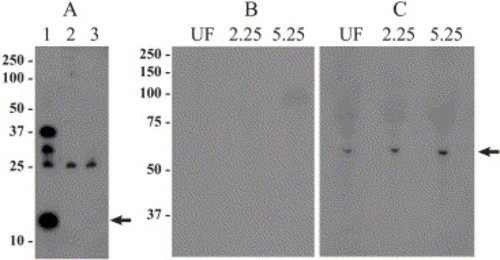Fig. 2
|
Detection of the Yes kinase in zebrafish embryos. The specificity of the anti-Yes antibody was tested by Western blot (panel A) of GST fusion proteins encoding the U + SH3 domain of zebrafish Yes (lane 1), the U + SH3 domain of Xenopus Src (lane 2), or the U + SH3 domain of zebrafish Fyn (lane 3). Fusion proteins were digested with thrombin to release the GST component, then resolved by SDS-PAGE, and blots were probed with the anti-Yes antibody. As seen in panel A, the antibody recognized the 13-kDa U + SH3 insert only in the sample from zebrafish Yes (lane 1, arrow). Higher MW bands in lane A represent partial digestion products containing Yes sequence. Some staining of the 25-kDa GST band was present in all samples, indicating that some anti-GST antibodies still remain in the partially purified antibody. The expression of Yes in eggs and early embryos was tested by Western blot of unfertilized eggs (UF), blastula obtained at 2.25 hpf, and early gastrula (50% epiboly) obtained at 5.25 hpf. Each lane was loaded with the equivalent of two embryos represented approximate 130 μg protein. The blots were probed with preimmune serum (panel B) or the partially purified antibody (panel C). The position of the 62-kDa Yes protein is indicated by an arrow at right. |
Reprinted from Developmental Biology, 277(1), Tsai, W.B., Zhang, X., Sharma, D., Wu, W., and Kinsey, W.H., Role of Yes kinase during early zebrafish development, 129-141, Copyright (2005) with permission from Elsevier. Full text @ Dev. Biol.

